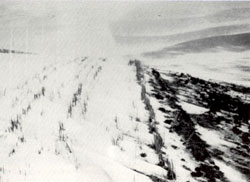Soil
Physics
Water movement
into the soil profile is a very dynamic and complex system
that is seldom at rest. The direction of its movement can be
dramatically affected by the cultural and tillage practices
used for crop production. An understanding of the basic
components of water infiltration is essential to producers
if they are going to efficiently manage their soil and water
resources.
Water absorption
and infiltration into the soil profile are affected by two
basic factors:
1) gravity and 2) matrix potential (attraction of water to
itself and soil surfaces). Gravity affects only the downward
movement of the water and the matrix potential affects both
downward and lateral flow. In the field, matrix potential is
usually the predominate force affecting water movement. See
Fig. 1.
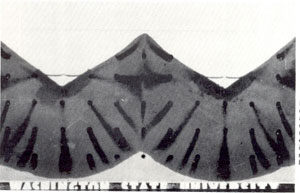 |
Fig. 1.
Gravity affecting only downward movement of water
and matrix forces affecting both downward and
horizontal movement. Dye or "streamer effect"
results when water is introduced at the soil V.
Water moves in all directions as show by the dye. |
In the course
of tillage, a layer or inconsistency in the soil is introduced
and affects water movement in much the same way as a sand or
gravel layer. (Even though there is a steep hydrolic gradient
between the wetting front and dry soil, water flow can be nearly
zero under these conditions.) The tilled ground has many large
empty pores as does sand and gravel with few surface contacts,
giving it less attraction for water (matrix potential). Before
water movement can proceed the large pores or channels must fill
to an appreciable volume or hydrolic conductivity. It is only at
this point when the wetting front can continue its downward
path. Coarse materials such as straw turned under by plowing
restrict rather than aid water flow in much the same way. Each
inconsistency or layer, weather it be worked ground, sand,
gravel or layer straw must be near saturation before water can
move down into the next stratification of soil. See fig. 2 and
fig. 3.
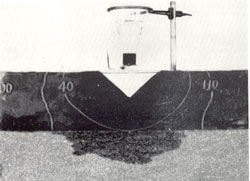 |
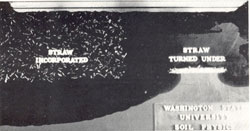 |
|
Fig. 2. Water retention over sand layer.
Saturation of a consistent soil type is necessary
before the water infiltrates to the next soil type. |
Fig. 3. Water retention over straw layer.
This inconsistent layer can be compared to a paper
towel. The towel will absorb water in all
directions. However, if you tear the towel in half,
only the half touching the water can absorb the
water. A plowdown of straw into the soil produces an
inconsistent layer or "tear" in the soil profile. |
The extremely
small pores or compacted soil found in hard pan from over
tillage also severely restrict water movement. This compacted
soil wts very quickley when first contacted by water due to its
high absorbtion capacity (high matrix potential due to large
surface area) yey, the rate of water movement is drastically
slowed because of its compacted nature. See fig. 4.
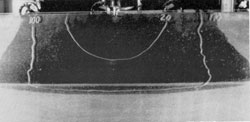 |
Fig. 4.
Water retention over hard pan. Hard pan results from tillage or a
calcium carbonate or caleachy layer.
|
|
